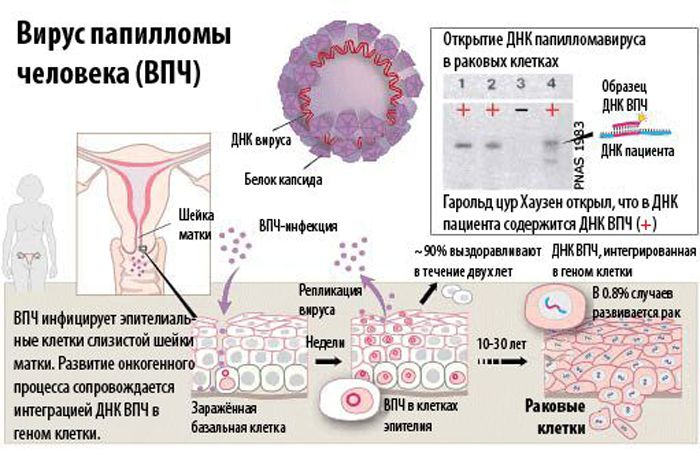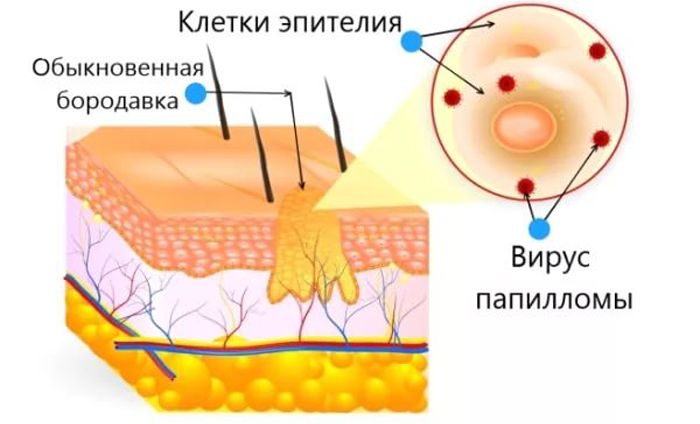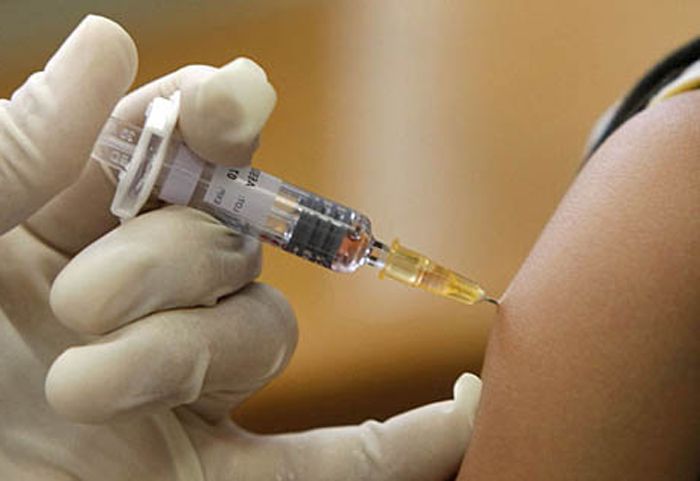100 varieties of papilloma viruses require classification, the codes of which indicate that it belongs to an established type, for example, the high oncogenic risk of HPV 16, HPV 18, HPV 45, HPV 56.
Pathogens lurk in the skin or urogenital tract. HPV 16, what is it? This is a stamp of the papilloma virus with type number 16, which poisons the existence of both men and women. It is mainly transmitted from a carrier to a partner during sexual intercourse. One contact is enough for infection.
But the activation of the virus depends on the immune system. With a strong immune system, it lives peacefully in the body for decades, without manifesting itself in any way. And throughout this period, the carrier can infect it through contact between partners. Are there any methods for determining the presence of a virus and how to deal with it, the essence of this article.
Infection methods and types
The carrier of the infection becomes a source of infection. This happens in one of the following ways:
- through household contact with a carrier, you can become infected through skin injuries: abrasions, cracks, scratches;
- during sexual contacts;
- self-infection when the virus gets on the skin due to injury, for example, shaving;
- infection of the child during childbirth.
A strong immune system does not allow the virus to manifest itself. It prevents the virus from multiplying. Therefore, it lives peacefully in the body for years. The virus activates and multiplies intensively when immunity decreases.
Obvious symptoms-neoplasms appear: papillomas, condylomas, warts. The type of papillomavirus manifests itself externally in different forms:
- a thin stalk, a soft formation correspond to genital warts. Located on the genitals and area of the anus, perineum;
- a soft, long formation on a thin stalk that matches the skin color or is slightly darker is considered a papilloma. Their distribution area is skin folds under the breasts, armpits, neck, face;
- the growths are large, hard, with defined boundaries and are warts. Localized on the soles, hands, knees, elbows.
The connection between papillomavirus and oncology
You can believe or not believe in the danger of a viral infection in the body. But for some reason, you often hear conversations about how, as soon as you pass the age of 50, and sometimes even earlier, diseases strike, one worse than the other.
In particular, now not a single doctor disputes the fact that the presence of HPV 16 in a woman’s body can lead to cervical cancer. Of course, this does not mean that cancer will happen to every patient. But recognizing the virus at an early stage and monitoring your health will prevent complications.

The importance of studying the relationship between cervical oncology and papillomavirus was noted by the Nobel Prize in Medicine. In 2008, it was awarded to the German scientist Harald Hausen. He proved that the cause of cervical cancer is the presence of the papillomavirus HPV 16 and 18 in the body.
Now almost every gynecologist strives to get an analysis for papillomaviruses and its types. According to the degree of oncogenicity, viruses belong to different groups:
- low risk of cancer - 6,11,42,43,44;
- average risk 31,33,35,51,52,58;
- high risk 16,18, 45, 56.
A patient may have several different types of HPV present at the same time.
HPV type 16 DNA replication occurs in the deep, so-called basal layers of the skin. Therefore, removing papilloma from the surface of the skin is ineffective and causes relapses, because the infection in the basal layer is the source of infection of the epithelial cells of the skin surface.

Papillomatosis goes through 4 stages:
- Latent, hidden period from the moment it enters the body until the manifestation of the response. During this period, papillomavirus 16 does not cause changes in cellular composition, but can be identified during a PCR examination.
- Clinical manifestation. The skin and mucous membranes become covered with growths and neoplasms. These growths make it possible to take material from the lesion for histological and cytological examination. The result will show the presence of human papilloma type 18 or type 16.
- Dysplasia triggers the mechanism for the introduction of infected DNA into healthy cellular DNA, i.e., the process of cell change begins.
- Papilloma type 16 turns into a malignant formation. Mutations appear in the body of a formerly healthy cell. As a result, invasive cancer cells are formed.
Human papillomavirus type 16 has its own specifics in women and men. As a rule, in men with HPV type 16, rashes in the form of genital warts appear on the penis and anus.
They contribute to the occurrence of intracellular malignant neoplasm of the anus and genitals. It is also possible that an additional disease may appear in the form of recurrent laryngeal human papillomavirus.
HPV in women
Human papillomavirus in women is usually asymptomatic. This can drag on for decades. Then genital warts appear. During an active sexual life, taking care of their health, women are recommended to undergo screening for papillomavirus types 16, 18 and 52.
Menopause becomes a powerful source of malignant tumors on the genitals. Papilloma type 16 in women has the peculiarity of provoking cervical cancer.
Disease and infection are not synonymous. A healthy body reacts homicidally to HPV, i.e. the pathogenesis is eradicated by the immune system. HPV type 16 in women under 30 years of age triggers the process of self-elimination of the virus - its destruction.
With increasing age, human HPV type 16 increases the risk of precancer and cancer in women and men. Conventionally, the peak of the disease occurs at the age of 45 years. Many countries have screening programs starting at age 30.
Vaccination as a means of preventing papillomatosis
Scientists around the world, realizing the importance of prevention, are intensively working to create vaccines that create immunity to the virus. Most attention is paid to the carcinogenic strains of HPV 16 and 18. The time is approaching to create a universal vaccine that includes protection against all papillomaviruses that cause oncology and benign neoplasms.

In certain foreign countries, vaccination of residents against papillomaviruses is part of the National Health Program to strengthen the immune system. In different countries, the vaccine is administered to girls aged 9 to 17 years before their first sexual contact.
Significant preventive efficacy and safety evidenced by worldwide experience is being reported daily. Vaccination of boys can prevent genital oncology and the formation of genital warts in both men and women. There are countries where it is mandatory.
People who have taken the full course of vaccinations are 99% likely to develop protective antibodies. These are excellent results in the prevention of HPV 16 and 18.
Changing the life of an HPV 16 carrier
What to do and how to live if the test shows the presence of HPV 16? Do not panic. After all, infection is not yet a dangerous disease. Moreover, in women, treatment, as a rule, is much delayed from the introduction of an infection that lives in the body asymptomatically.
Life will continue under constant medical supervision. First of all, the doctor will prescribe the necessary treatment procedures aimed at eradicating the external manifestations of HPV. Constantly worry about strengthening your immune system. It is better to contact an immunologist with this question.
Only powerful immunity will minimize the factors of cancer. Once a year, and perhaps more often, you need to be examined for cancer. And if suddenly a tumor is discovered, it will be the first stage, which has 100% curability.
Treatment of female HPV 16 disease comes down to 3 phases:
- local therapy;
- general drug treatment;
- fight against cancer tumors in case of late detection.
Basically, the treatment methods have already been described along the way. Local therapy involves removing growths from the surface of the skin using any available method:
- cryodestruction;
- cauterization;
- laser;
- surgery.
General drug treatment consists of taking antiviral substances and vitamin-mineral complexes to maintain immunity. This also includes stabbing, proper nutrition, and getting rid of bad habits. Anything that will support the immune system.
If HPV 16 has done its dirty work and oncology, dysplasia is discovered late, then typical methods of treating oncology are used:
- chemical therapy.
- radiation therapy.
- surgery.
As always, we remind you that it is easier to prevent a disease than to treat it. You should always remember the harmfulness of HPV 16 and monitor your health.
